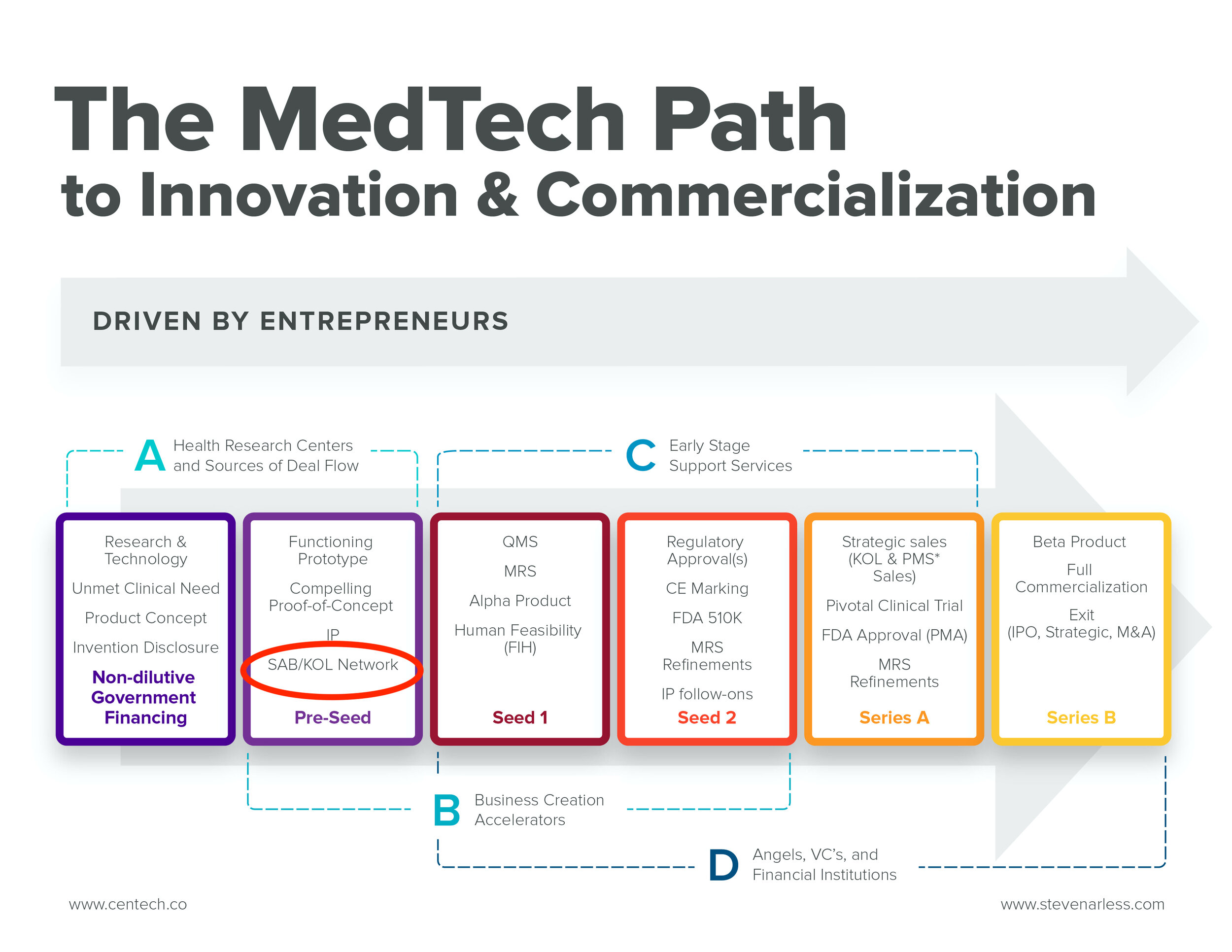In my experience as a MedTech start-up entrepreneur, the most critical business strategy leading to success involves KOL selection, their management and organization. This is particularly true in the USA, where regional and national KOL’s play a dominant role across all aspects of the MedTech commercialization process.
In the infographic above, the business milestones relating to KOL’s begin at the earliest stages of a MedTech start-up, in parallel with confirming a clinical unmet need, translating it into a precise product concept, and determining what is a compelling proof-of-concept. Without KOL input, these critical start-up activities may never be successfully executed!
What is a KOL?
A KOL is either a clinician and/or scientist that has developed and earned visionary leadership in their medical field. They typically have earned peer respect and admiration, and can influence future treatment solutions.
A KOL understands how to work in partnership with the private sector, and understands how to optimize the working relationships with innovative companies in order to achieve prominence with other key stakeholders in the their healthcare ecosystem.
KOL’s not only excel in clinical research, but also in how to build strategic relationships with VC’s, regulatory bodies and business leaders.
Equally significant, KOL’s are often able to help MedTech entrepreneurs map out the process involved in using a potential new product – that is, how doctors and scientists actually use the solution in their daily work. This is critical in highlighting any current design flaws and in developing a product that is fit for purpose.
How to Identify a KOL?
KOL’s are typically prominent at regional and medical conferences, and often dominate the scientific programs, panel discussions and debates. Most KOL’s are excellent speakers, and present their work in a very clear and compelling manner. Publications in peer-reviewed journals are regularly written by KOL’s.
What makes a great KOL?
In addition to impeccable scientific and clinical skills, great KOL’s demonstrate great social and public speaking skills. The best are not only comfortable with business interactions, but are very comfortable in conversations and relationships with Corporate Strategics and start-up CEO’s, as well as VC’s who constantly rely on their insight for clinical unmet needs and future technology solutions.
Why is a KOL strategy so critical for MedTech start-ups?
Developing a KOL support group (often comprised of KOL’s and Scientific Advisory Board members) is the best way for MedTech start-ups to effectively deal with several critical success factors:
Developing a clinical validation program for your product that carries weight with clinical and regulatory players
Giving credible endorsement throughout the VC due diligence
processProviding guidance for start-ups as they navigate through the very complex reimbursement process in the USA
How do I build a great KOL strategy?
The best (and most simple) way to build a KOL strategy is to:
1. Identify your key KOL leader – you need to know who you want before you begin networking your way to him/her. Typically you’re looking for someone with a significant North American presence!
2. Then, beginning with your existing contacts – reach out and make use of key people in your own immediate ecosystem to lead you to the targeted KOL. The old adage “It’s not what you know, it’s who you know” applies here.
3. Once you’ve been able to develop a relationship with that key KOL, work with him/her in expanding your KOL team accordingly. Ask them: “Who else do you think we should be including on the KOL team?” Given their prominence as mentioned above, they will undoubtedly have a strong network in every area of the ecosystem, including other KOLs that can help you validate or refine your product. A great KOL team starts with a great leader!
This sounds easy, and I understand it is more doable (given my experience) to tap into KOL’s as valuable resources. But I started somewhere too, and developed these relationships one KOL at a time.

